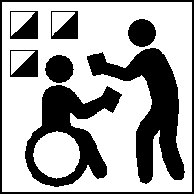Trail Orienteering
Trail Orienteering , or Trail-O for short , also called Precision Orienteering , is a variant of the sport of orienteering that is also suitable for athletes with disabilities . Since only orientation skills count in the Trail-O and the speed of movement is irrelevant, the sport can be practiced side by side by people with and without disabilities. Internationally, precision orienting is organized by the International Orienteering Federation (IOF) .
regulate
As with traditional orienteering, with Trail-O you have to orientate yourself with the help of a map and compass. In contrast to this, the posts do not have to be visited directly on the Trail-O , but only identified from a distance from easily accessible viewpoints along the way (hence the name "Trail-O"). Several control markings can be seen from each vantage point, with the help of a map and control description , the control indicated on the map must then be marked on a special multiple-choice control card . The winner is the competitor with the most correctly marked items; in the event of a tie, the time until the item is marked can also decide, which is measured for some items, the so-called time controls . The time to complete the entire course does not matter, however, the route can be completed on foot, with sticks, with a wheelchair or with physical support from auxiliary staff. The only exceptions are vehicles with internal combustion engines.
In the meantime, in addition to the Trail-O without a time limit, which is referred to as PreO , another variant of the Trail-O, the so-called high-speed orientation or TempO , has developed. The TempO discipline consists exclusively of so-called time controls, in which items are determined under time pressure and corresponding penalties are assigned for incorrect answers. In addition to PreO and TempO, Trail-O relay competitions are also held at international championships.
With the Trail-O, the orientation accuracy is particularly crucial, which is why "Precision Orientation" has now been officially chosen as the German name for Trail-O. (Also in the Anglo-American and Scandinavian-speaking English precision orienteering , Swedish Precision orientation ), this designation usual. In order to enable precise orientation, particularly detailed orientation maps are used for the Trail-O , mostly on a very large scale such as 1: 5,000 or 1: 4,000.
history
Since the 1980s in particular, there have been various attempts to give people with disabilities access to orienteering. One possibility for this was the wheelchair orienteering race. In contrast to this, however, precision orientation was developed with the aim of exclusively using orientation performance as a basis for competition and thus ensuring the same chances in competition for people of different physical abilities.
European championships were held for the first time in 1994 and have been held annually since then, now every two years. World championships have been held annually since 2004, and the IOF has had an official Trail-O world rankings since 2018. The unofficial European Cup in Trail-O ("European Cup in Trail Orienteering", ECTO for short ) , which has been held since 2013, is another top-class international competition series .
literature
- Anne Braggins: Trail orienteering: an outdoor activity for people with disabilities . Harveys, 1993, ISBN 1-85137-090-0 (English).
Web links
- trailo.org (English)
- Trail-O in Germany
- Trail-O on the website of the International Orienteering Federation (IOF)
Individual evidence
- ↑ a b c Trail Orienteering on the website of the International Orienteering Federation IOF, accessed on December 14, 2019.
- ↑ Orienteering in Germany - definition of the sport of precision orienting. Retrieved December 14, 2019 .
- ^ A b Ian Bratt: Orienteering. Training - technique - competition . 1st edition. Pietsch, Stuttgart 2004, ISBN 3-613-50447-2 , p. 72 (English: Orienteering. The essential guide to equipment and techniques . Translated by Hermann Leifeld).
- ↑ ECTO history on the Italian Trail-O homepage. Retrieved December 14, 2019 .

